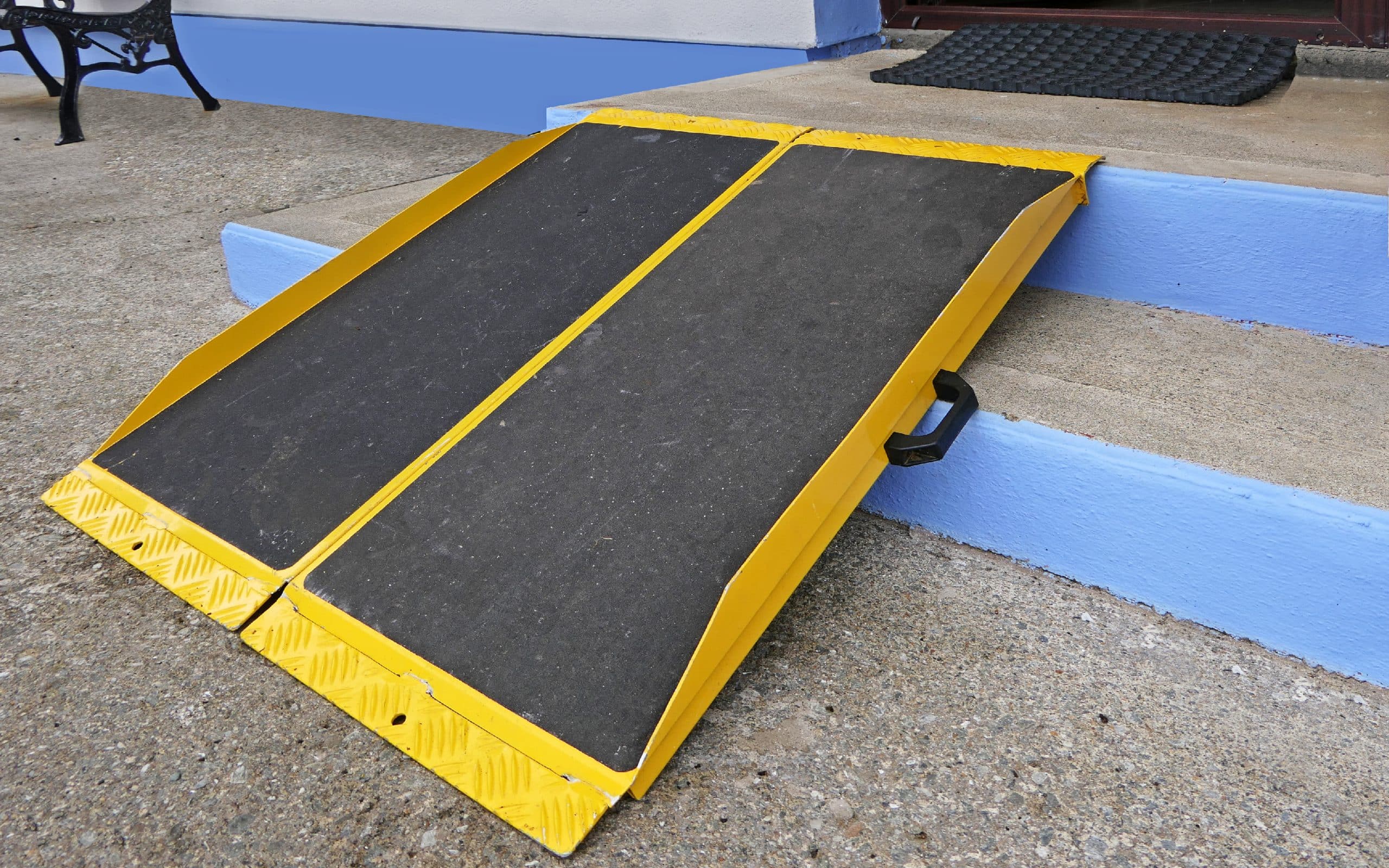Keeping your home safe and accessible for older adults is absolutely essential. Navigating stairs is one area in particular that needs special attention, as steps can pose a serious hazard for those with limited mobility.
Thankfully, some solutions are both simple and affordable. Portable ramps for stairs are an ideal answer to providing safe access up and down steps, both indoors and out.
In this guide, we’ll take a closer look at why homeowners should consider portable ramps for stairs, the different types of portable ramps available, how to select the right one for you, and other helpful tips.
What Is a Portable Ramp for Stairs?
A portable ramp is a temporary yet sturdy sloped surface used to provide safer access to areas with stairs, door thresholds, or other obstacles. They are usually made of lightweight materials such as aluminum, rubber, or plastic and can be moved easily from one place to another.
Portable ramps provide safe access for individuals who have difficulty navigating stairs or use wheelchairs, walkers, or canes to get around. These types of ramps typically are used for small obstacles such as one to two steps, door thresholds, or changes in elevation throughout the home.
For stairways with three or more steps, other solutions such as stairlifts are recommended.
Benefits of a Portable Ramp for Stairs
There are many reasons why homeowners should consider investing in a portable ramp. Aside from providing safe access for residents with limited mobility, they also make it easier for guests to visit your home. You can avoid accidents and serious injuries by installing a portable ramp in any place with steps or a small number of stairs.
Portable ramps are easy to install and can be removed when not in use. They also provide an affordable solution for improving accessibility in the home without having to make permanent changes to the structure of the house.
Types of Portable Ramps for Stairs
When considering a portable ramp for your home, there are several types to choose from.
Aluminum
Aluminum ramps are strong and lightweight, making them easy to move and install. You can find a wide range of aluminum portable ramps for stairs available from numerous manufacturers.
Rubber
Rubber ramps are durable, slip-resistant, and easy to handle. They also can be more costly than other types of portable ramps for stairs.
Plastic
Plastic ramps are lightweight and easy to install and come in a wide range of prices. However, they also may not be as durable as other options.
Wood
Wood ramps offer a more aesthetically pleasing option but require more maintenance than other types. While portable, they also tend to be heavier and more challenging to move.
What to Look for in a Portable Ramp for Stairs
When selecting a portable ramp, there are several factors to consider.
Length
How long does your ramp need to be? As a general rule, the ADA (Americans with Disabilities Act) recommends that the slope of an accessibility ramp be 1:12, meaning that for every inch in height, the ramp should have at least 12 inches of ramp length. When choosing a portable ramp for stairs, you want to make sure the ramp is long enough to provide safe access to the stairs.
Weight
Weight capacity is also important because it needs to be able to support the weight of the user and any equipment (such as wheelchairs) they may be using. Depending on the layout of your home, features such as handrails and non-slip surfaces should be taken into consideration as well.
Price
Cost is always a factor for most homeowners. You want a ramp that fits within your budget yet still ensures safe navigation of stairs. The prices of portable ramps for stairs can vary widely, so you’ll need to do some shopping before purchasing. You may also want to consider reading user reviews and/or asking other users about their experience with the product.
Safety
You always want to maintain safety, even when cost is involved. The well-being of the people living in or visiting your home is paramount when choosing a portable ramp. Always look for one that meets all safety requirements.
Installation of Portable Ramp for Stairs
Once you have selected the right portable ramp for your home, you’ll need to install it. While installation is relatively simple, you’ll need to do some measuring beforehand to make sure the portable ramp will fit in your home and stairs.
When installing a portable ramp on stairs, please follow all manufacturer instructions outlined in the installation manual. If the ramp comes with any bolts or screws, make sure they are securely tightened and check all connections before use.
Maintenance and Safety Tips
Inspect your portable ramp regularly to check for any damage or wear on the ramp itself, the stairs, or any connections that may be present. Remember, a portable mobility ramp is not a toy, so it should be used properly at all times.
Take care not to overload the ramp beyond its recommended weight capacity.
Also take the time to clean the ramp regularly, as dirt and other substances may deteriorate the non-slip surfaces or build up minor — yet still dangerous — obstacles.
Find Help at Havenside
Portable ramps are an ideal solution for homeowners looking for an affordable way to improve accessibility in their homes while providing safe access for family members or guests with limited mobility.
If you have questions about which portable ramp is best for you, how to measure your space, or even how to finance the purchase of a portable ramp, please contact the team here at Havenside. We’re here to help homeowners make modifications that make their homes safer and more accessible for older adults and others with mobility issues.

